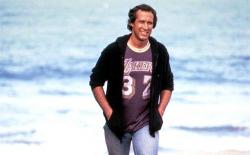The Revenant (15)
Directed by: Alejandro González Iñárritu
Starring: Leonardo DiCaprio, Tom Hardy & Will Poulter
Running time: 156 min
A frontiersman named Hugh Glass on a fur trading expedition in the 1820s is on a quest for survival after being brutally mauled by a bear.
That scene happens 25 minutes into the film.
Hugh Glass, Leonardo Di Caprio’s central character in Alejandro Gonzalez Inarittu’s The Revenant, is stalking some bear cubs in an eerily quiet forest somewhere deep in America’s harshest frontier. As he approaches with caution, he suddenly hears the rampaging parent. From that point, we’re strapped in and plunged into one of the most brutal and gut-churningly immersive man vs animal sequences ever put on the big screen. Glass attempts to fend off the bear with his rifle, managing to get one shot in, but it’s not enough to protect him from the ferocity that ensues. The scene is utterly horrifying.
Watching Di Caprio’s character hurled around mercilessly on the ground will stay with you, long after you’ve emerged from the whimpering foetal position you’ve assumed watching the events unspool before you.
The Revenant will not be a film for everyone. Indeed, two hours into the film, it’s difficult to determine whether this really is a masterpiece. It’s certainly a visceral, astonishingly brutal feat of endurance cinema and an immensely vivid portrait of survival in the most unforgiving conditions, but at its heart it’s purely a simple revenge tale. Inarritu, who must be highly commended for managing to get the film released a year after the multiple Oscar-winning Birdman, alongside cinematographer Emmanuel Lubezki unleash the most brutal elements on you. It’s easy to feel every struggling breath from Di Caprio, every crawl through the snow, every arrow to the head. It’s definitely an immersive, absorbing, harrowing experience, plunging the audience into an uncompromising 19th century Montana and South Dakota.
The opening scene of the film sets up the beauty and brutality of the picture. Glass has joined a group of privateers engaged in a US military expedition along the Missouri river. Their mission is to find a lucrative fur-trapping base. Led by Andrew Henry (Domhnall Gleeson), they are ambushed by a squadron of tribesman-warriors in an electrifying sequence that showcases the striking, innovative techniques used to make the audience squirm and writhe helplessly when blood is shed and violence rages.
It’s reminiscent of Steven Spielberg’s unflinching Omaha Beach opening to Saving Private Ryan, a piece of filmmaking that captures the senses in exhilarating fashion, as we are submerged into the “edge of the world.” Glass, a vastly experienced and expert tracker, guides the men to safety before setting forth on their quest through the forests and mountains. Then, as he is scouting the path ahead on his own, the bear attack happens and we are left with a gruesome image of flesh dangling from his battered body. When his companions discover him half-dead and wheezing for dear life, they agree that their expedition is too brutal and the terrain too merciless to carry Glass as he desperately holds on for his last breath.
Gleeson’s captain Henry details Jim Bridger (Will Poulter) and John Fitzgerald (an eye-poppingly pugnacious Tom Hardy) to stay back and look after him. However, after sensing trouble, they scurry out of their camp and leave Glass to die in agony, underestimating Glass’s immense will to survive against the odds – and bears. From that point, the film becomes a flat-out revenge thriller set against the breathtakingly bleak and pitiless surroundings, from which we see Di Caprio’s unremitting commitment to the role, grunting and rasping his way through an overwhelmingly pitiless environment.
Indeed, the long, unbroken takes of Glass trudging his way to revenge set to Ryuichi Sakamoto’s haunting score can only be described as a symphony of pure, sensory cinema. It’s an aesthetic marvel – and something which would have been awesome to behold in 70mm format.
However, where The Revenant ultimately falls short of being considered an unbridled masterpiece is the muddle of Terrence Malick-esque existential strokes and Warner Herzog’s Aguirre: Wrath of God, considered by many to be the definitive cinematic descent into madness. Yes, Inarritu and Lubezki have created a sweeping, meditative poem of cinema that will have aspiring DP’s yelling with delight, but it’s perhaps too self-admiring for the everyday cinemagoer.
The spectral visions of various indigenous characters whispering sweet survival nothings into Glass’s consciousness, as he overcomes the impossibly heartless snowscapes of this eye-catching American frontier, never develops enough emotional conviction to impress. Inarritu intersperses Glass’s feats of survival with ghostly, hallucinatory imaginings that only serve to remind that he is a director who is best at truncheoning the audience into submission.
There’s plenty of awe-inspiring elements here, for sure. The performances portray the now legendarily arduous shoot, from Di Caprio tucking into a freshly-killed bison, to wrapping up for a peaceful night’s sleep inside a different animal’s carcass. It’s a reminder, too, of Di Caprio’s versatility. From his bombastic, histrionic portrayal of notorious stockbroker Jordan Belfort in Martin Scorsese’s The Wolf of Wall Street, he is transformed into a nearly wordless, stripped-to-the-bone entity. He succeeds in building the definitive portrait of human suffering you’re ever likely to see.
Ultimately, Inarritu’s plunge into the wilderness will be utterly inaccessible for some. At 156 minutes long and punctuated with several dialogue-less scenes, it’s certainly a world away from the comic brilliance of Birdman, and ultimately a less enjoyable trip. However, it demands to be seen, if not for Lubezki’s magnificent natural-light cinematography, then for some of the most deeply unsettling and extraordinarily potent cinematic sequences you will ever experience.
4 out of 5 Nerds





Nerd Comments